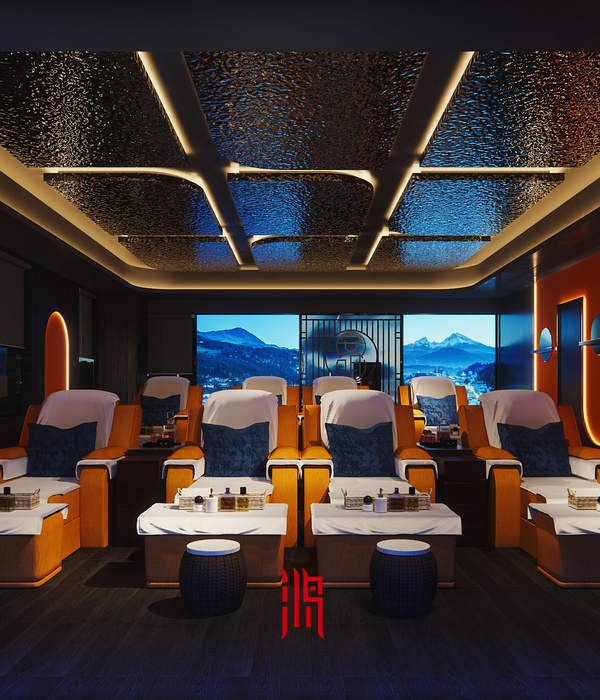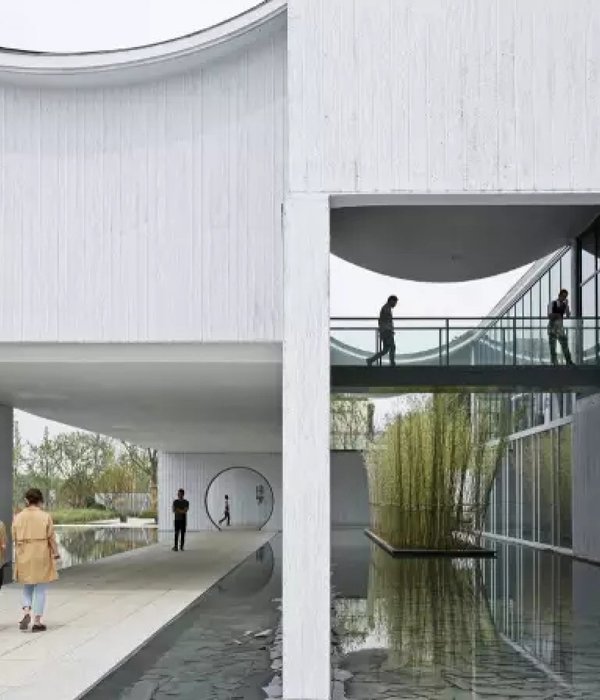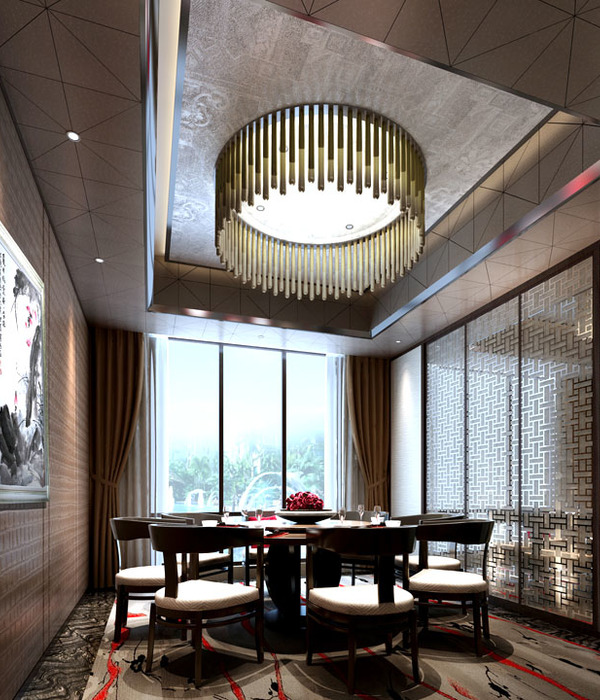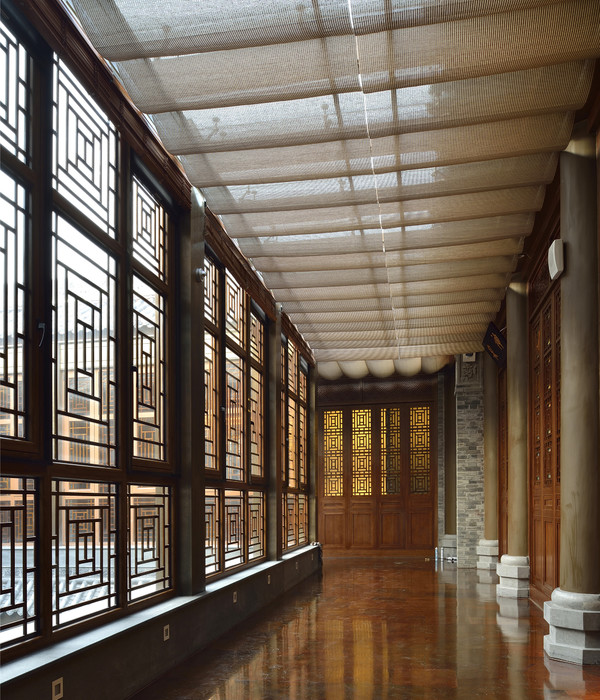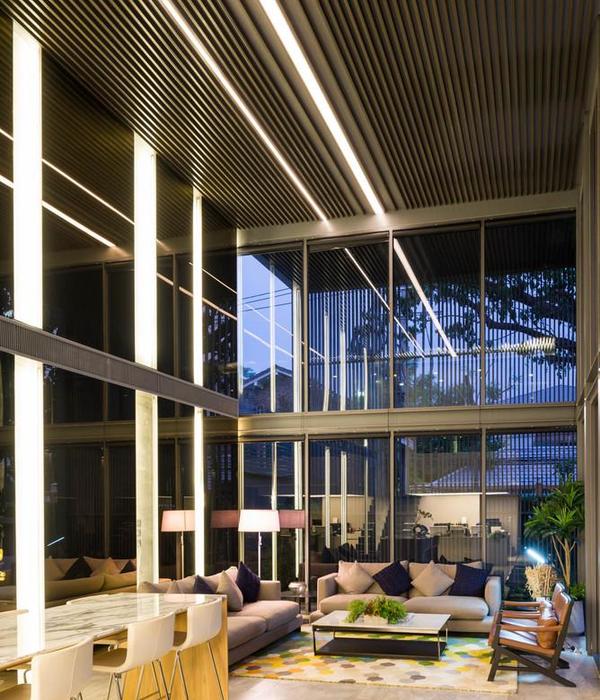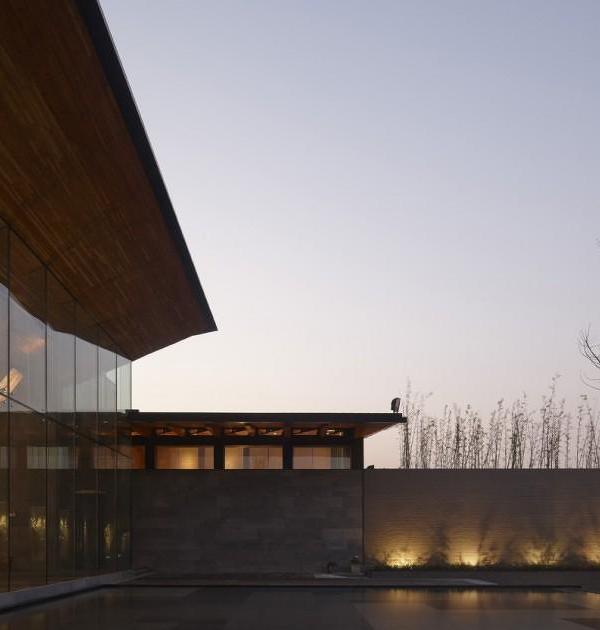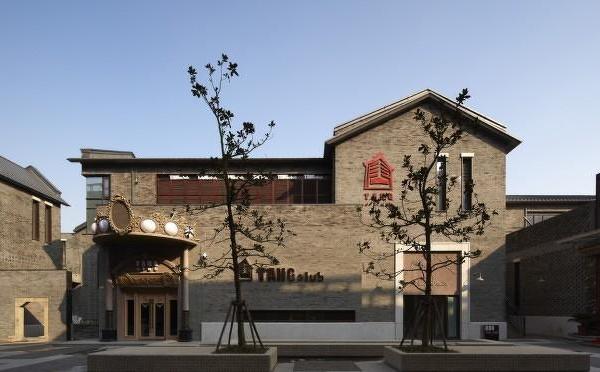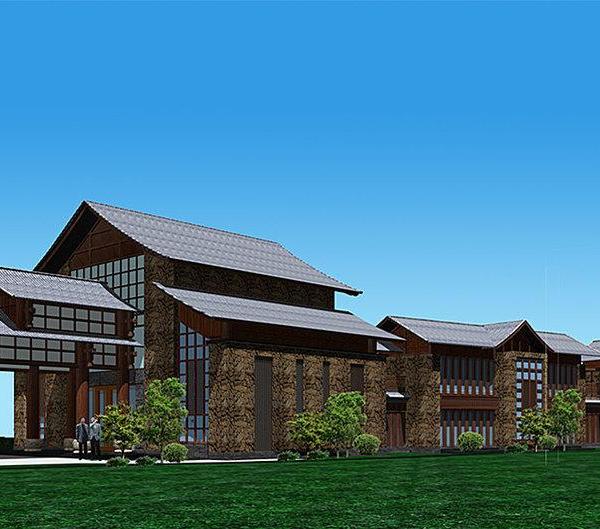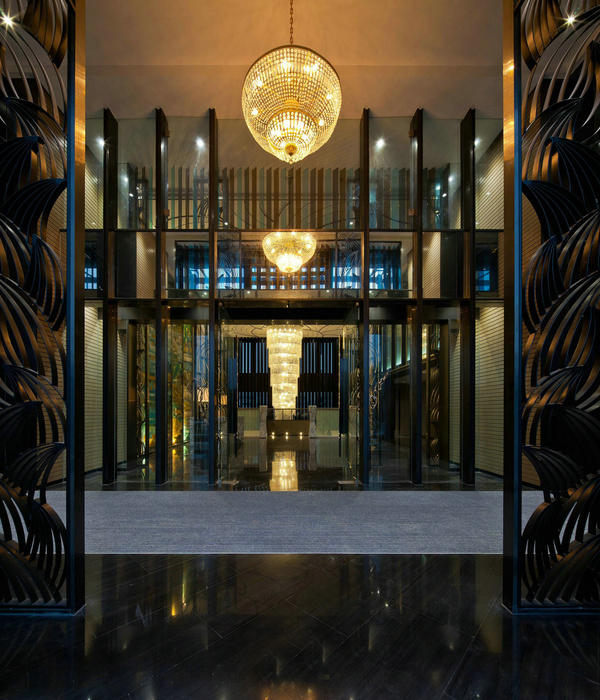如果说2019年阿那亚三亚的首开区是致舍对沙生植物和侘寂美学在8千平米区域内探索的开端,那么通过三年多时间建设的南花园,则是我们对这个位于三亚自然山谷中的20公顷花园社区进行景观设计实践的过程,我们经此有了更全面深入的思考和收获。
If the demonstration zone of Sanya Aranya in 2019 was the beginning of exploring cactus plants and Wabi-sabi aesthetics in an 8,000 square meter area, then the south garden project, which was constructed over more than three years, is our landscape design practice for the 20-hectare garden community located in a natural valley in Sanya, with a more comprehensive and in-depth reflection and achievements.
▼视频,Video
在延续首开区定调的沙生植物和侘寂美学的基础上,作为山地改造类型的南花园项目面临着场地带来的挑战:早期的开发建设对场地和山体肌理造成了破坏,使得山谷绵延的绿意在地块红线外戛然而止;在竖向落差近35米的场地上景观空间被前一轮开发遗留的较高密度建筑压缩得极其有限。
面对场地限制,如何修复场地与山体、人与自然之间的联系;如何克服原场地的不利条件,因地制宜,建立好景观的“骨架”,并通过对景观设计中重要的因素——地形和植物的设计营造,让高差处理不生硬,让绿色在社区之中蔓延,还原山林地的自然感受,成为我们在设计上的目标。
在南花园项目中,景观设计上最大的突破是山间地形的处理、雨林和沙生植物”快慢相持“的造景方式,以及在不同标段的植物配置和选种上采用“迭代”的方式去应对景观的时间性和变化性。我们前后采用了三百多种节水低维护和慢生性的沙生植物,与上百种本地速生的雨林植物相结合,构建起社区的生物多样性体系。
同时我们试图用现代设计的手法和语汇去诠释和表达对中国园林传统的造园理论“虽有人作,宛自天开”“曲径通幽”等的欣赏和领悟。
Based on the continuation of the cactus plants and Wabi-sabi aesthetics established in the demonstration zone, as a mountain transformation type project, the south garden project faces challenges from the site: early development construction has caused damage to the site and mountain texture, resulting in the greenery of the valley abruptly ending beyond the red line of the land plot; on the site with a vertical drop of nearly 35 meters, the landscape space is compressed extremely limited by the high-density buildings left over from the previous development.
To overcome the limitations of the site, we focused on restoring the connection between the site and the mountain, as well as between humans and nature, and adaptively establishing the “skeleton” of the landscape design. Through the design and creation of the most essential elements of landscape design, terrain and plants, we aimed to handle the elevation changes in a natural way, maximize the spread of greenery in the community, and restore the natural feeling of the mountain and forest land.
The biggest breakthrough in landscape design in the south garden project lies in the handling of the mountain terrain, the “slow and fast” of rainforest and cactus plants, and the use of “iteration” in plant design and selection to deal with the temporal and spatial changes of the landscape. We have used over 300 drought-resistant, low-maintenance, and slow-growing cactus plants, combined with over a hundred local fast-growing rainforest plants, to create a biodiversity system in the community.
At the same time, we attempted to interpret and express the appreciation and understanding of traditional Chinese garden theory, such as “although people create it, it is as if it were from heaven” and “winding paths lead to secluded spots”, using modern design vocabulary.
▼隐入山林,Hidden in the mountains © morefotos
在整个设计中,用纯粹和质朴的空间和材质,少有装饰物,让人们在山居中回归静谧,欣赏大自然之美和植物之趣,与土地建立更为真切的联系。
该项目成功地重新激活了该区域的活力,渐渐生长成为一个受人喜爱的、与自然共生的、山海之间理想的花园社区。
Throughout the design, with pure and simple space and materials, and few decorations, people can return to tranquility in the mountainous surroundings, appreciate the beauty of nature and the interest of plants, and establish a more intimate connection with the land.
The project has successfully rejuvenated the vitality of the area and has gradually grown into a beloved garden community that coexists with nature in the mountainous and seaside environment.
▼微风之丘,Breeze Hill © morefotos
▼林泉高致,Fountain Fall © morefotos
▼曲径通幽,The winding path © 瑾怀
1. 项目背景——山海间 Project Background – Between Mountains and Sea
三亚位于海南省最南端的滨海丘陵地区,北高南低,半山半海,因而古称“崖州”。在大规模建设以前,这里并没有成排的椰子林和喧闹的人工海岸。海边的滩涂上,有木麻黄、相思树、仙人掌等本土的滨海沙生植物,追随着潮起潮落,日复一日地生长。而到了群山之上则是枝繁叶茂的原生热带雨林,榕树、榄仁、青梅等高大的乔木遮天蔽日,成为各种动物栖息的家园。植物的脉络由海到山延续,人们也耕息于山海之间。就在场地不远处,至今仍保留着原住民的聚落,农户们依山傍海劳作,日落后回到山林之间的小院,大榕树下围坐谈天。他们的生活并不光鲜热闹,却与土地紧密连结,有着真实并温和的生命力量。
回溯三亚的自然与历史,是一次关于跨越山海的旅行。而原生植被与原住民,是在这片土地上存续最久的生命。相比人工塑造出的三亚,这样自然的三亚更能给人归属感与认同感,也成为了致舍探索阿那亚三亚南花园的起点。
Sanya is located in the hilly coastal area in the south part of Hainan Province, with higher elevation in the north and lower elevation in the south, with the sea on one side and mountains on the other. Therefore, it was formerly called “Yazhou”.
Before the large-scale development, there were no rows of coconut groves and noisy artificial beaches. On the beach tidal flats, indigenous coastal cactus plants such as Casuarina equisetifolia L., Acacia confusa Merr, and Opuntia dillenii (Ker Gawl.) Haw.grew day by day following the tide. On the mountains, there are lush original tropical rainforests, towering trees such as Ficus microcarpa L. f., Terminalia catappa L. and Vatica mangachapoi Blanco, providing a habitat for various animals. The plant extends from the sea to the mountains, and people cultivate the land between the mountains and the sea. Not far from the site, there are still settlements of indigenous people. Farmers work on the mountain and by the sea, and return to their small courtyards in the forest after sunset, sitting under big banyan trees, chatting. Their lives are not glamorous and lively, but are closely connected with the land, and have real and gentle vitality.
To trace the nature and history of Sanya is like taking a journey across mountains and seas. The original vegetation and indigenous people are the longest surviving life on this land. Compared with the artificially created Sanya, this natural Sanya can give people a sense of belonging and identification, and has become the starting point for exploring the aranya Sanya South Garden.
▼区位图,Location © Z’scape
▼到达路径,Arrival © morefotos
2. 项目基址——山林地
Project Location – Mountain Forest Land
计成在《园冶》中理想园居首推“山林地”,所谓“园地惟山林最胜,有高有凹,有曲有深,有峻而悬,有平而坦,自成天然之趣,不烦人事之工”。因地制宜,顺应山势营建园林,自然而然会产生高与低、平与曲、远与近、旷与奥的变化,这是刻意营造无法达到的高度。
此外,许多文学、绘画作品都以“山居”来表达理想生活的境界,从谢灵运的始宁墅到王维的辋川别业,山林不仅给人空间上的变化,更带来一种远离喧嚣的宁静和向内探索的追求。
In the book 《Yuanye》, Jicheng highly recommends the ideal garden residence – “mountain forest land”, which means “the best garden land is in the mountains and forests, with ups and downs, twists and turns, steepness and flatness, forming a natural beauty without the need for human effort.”
Adapting to the terrain and constructing gardens in harmony with nature will naturally produce changes in height and depth, twists and turns, distance and proximity, and openness and mystery that cannot be achieved through deliberate construction. In addition, many literary and painting works use “mountain residence” to express the realm of ideal life, from Xie Lingyun’s Shiningshu villa to Wang Wei’s Wanchuan Bye Business.
Mountain forests not only bring spatial changes to people, but also bring a kind of tranquility away from the noise and the pursuit of inner exploration.
▼项目背景和南花园2022年1月完工鸟瞰图,Context & Site photo in January 2022 © morefotos
阿那亚三亚南花园的选址,亦在一片山林地。场地位于三亚吉阳区的南下岭腹地,毗邻中央商务区,却因群山环抱而得有一方难得的静谧。
在设计中,致舍希望能够珍惜山林的价值,因地制宜地对待场地。对于“山”,尽可能依据现状地势展开设计,让人们能够感受到山林环抱的空间与起伏错落的变化;对于“林”,恰如计成所言“多年树木,碍筑檐垣;让一步可以立根,斫数桠不妨封顶”,保留场地上的原生大树、见缝插绿,渐渐恢复植被与山林的自然环境相融合。
The site of aranya Sanya South Garden is also located in a mountain forest land. The site is located in the hinterland of Nanxiangling, Jiyang District, Sanya, adjacent to the Central Business District, but has a rare and quiet environment due to the surrounding mountains.
In the design, Z’scape hopes to cherish the value of the mountain forest and treat the site according to its local conditions. For the “mountain”, the design is developed as much as possible based on the existing terrain, so that people can feel the spatial envelopment of the mountain forest and the ups and downs of the terrain.
For the “forest”, as Jicheng said, “trees that have grown for many years obstruct the construction of eaves and fences, but let the roots take root with one step, and cut several branches without hindering the top.” Existing large trees on the site are preserved, and greenery is planted in the gaps, gradually restoring the vegetation and integrating with the natural environment of the mountain forest.
▼保留场地上原有的大榕树, The retained banyan tree © 林半野
3. 南花园 South Garden
挑战及目标 | Challenges and Objectives
相较于理想“山林地”的愿景,南花园项目面临着一些挑战:首先,早期的开发建设对场地和山体肌理造成了破坏,使得山谷绵延的绿意在地块红线外戛然而止;其次,在竖向落差近35米的场地上,景观空间被前一轮开发遗留的较高密度建筑压缩得极其有限,存在着诸多不可重来和无法移动的因素(综合管网、地下基础、设备间)。
面对这些场地限制,如何修复场地与山体、人与自然之间的联系;如何克服原场地的不利条件,因地制宜,建立好景观的“骨架”,并通过对景观中重要的因素——地形和植物的设计营造,让高差处理得不生硬,让绿色在社区之中蔓延,还原山林地的自然感受,成为设计上的目标。
Compared with the vision of the ideal “mountain forest land”, the South Garden project faces some challenges:
Firstly, early development and construction have caused damage to the site and the texture of the mountain, resulting in the lush greenery of the valley abruptly stopping outside the red line of the site.
Secondly, on the site with a vertical drop of almost 35 meters, the landscape space is extremely limited due to the high-density buildings left by the previous development, and there are many factors that cannot be repeated or moved.
Faced with these site restrictions, how to restore the connection between the site and the mountain, and between people and nature; how to overcome the unfavorable conditions of the original site, adapt to the local conditions, establish the “skeleton” of the landscape, and create the most essential factors of the landscape – terrain and plant design, handle the elevation changes in a natural way, and spread greenery to the maximum extent in the community, restoring the natural feeling of the mountain forest land, becomes the objective of the design.
▼隐入山林,Embedded in the mountains © morefotos
设计策略 | Design Strategy
在平面布局上,我们重新梳理建筑与道路的关系,推敲高程,建立好景观的空间骨架。梳理后的道路系统如社区的“毛细血管”,将一个个绿色带状或点状的小微花园布置在主入口、道路、巷道口、巷道、院落门口的归家路线上,使绿色蔓延进入场地中;同时,也让天空之镜、微风之丘、南会所等较开阔的公共空间被绿意所环抱。以动静兼具的景观系统,建立起人与自然和谐共生的场景,营造山海之间理想的花园社区。
In terms of the layout, we have reorganized the relationship between buildings and roads, carefully considered the elevation, and established the spatial framework of the landscape. The road system, reorganized as the “capillaries” of the community, is arranged with small gardens in strip or dot shapes along the homecoming route of the main entrance, roads, alleyway intersections, alleys, and courtyard entrances, spreading greenery into the site.
At the same time, the more open public spaces such as Sky Mirror, Breeze Hill, and South Club are also surrounded by greenery. With a landscape system that combines dynamism and stillness, we establish a scene of harmonious coexistence between people and nature, creating an ideal garden community between the mountains and the sea.
▼南花园景观结构图,Structure map © Z’scape
▼与远山相呼应的“微风之丘”,The Breeze Hill © 瑾怀
▼绿意环抱的“天空之镜”, “The mirror of sky” © morefotos
在竖向关系的处理上,设计团队根据现有建筑标高以及自然山势的变化,运用不同的景观要素塑造空间。我们并不回避现状测绘图纸的误差造成的不确定性以及景观与山地建筑交接处的复杂性,而是去充分尊重现状的差异,在反复的调改中,利用限制条件来创造变化和惊喜。
就像传统聚落中美丽的肌理一样,自发的建造总是经过邻里间年复一年的商议、制衡,才形成了舒适的空间组织和合理的边界形态,因地制宜的美感是标准化设计永远无法超越的。南花园亦没有既定的模式和标准化的手法,而是为每种具体的诉求寻找最合适的解决方案。
进入建筑入口的方式、院墙挡墙的拆改与设立、种植空间的分布、材质的选择都在与地块条件的契合中生长而成,依山而成的四十一条巷道各不相同。
Design Strategy In terms of vertical relationships, the design team used different landscape elements to shape spaces based on existing building elevations and natural terrain changes. We did not avoid from the uncertainty caused by errors in the existing site survey drawings and the complexity of the interface between landscape and mountain architecture. Instead, we fully respected the differences of the existing conditions and used constraints to create change and surprise through repeated adjustments.
Just like the beautiful texture in traditional settlements, spontaneous construction always requires years of discussion and balance between neighbors to form comfortable spatial organization and reasonable boundary forms. The aesthetic of adaptability to local conditions is something that standardized design can never exceed.
The South Garden does not have a fixed pattern or standardized approach. Instead, we look for the most suitable solution for each specific demand. The way to enter the building, the distribution of planting spaces, the setting of retaining walls, and the choice of materials all grow and develop in accordance with the site conditions, resulting in 41 different alleys formed along the mountain.
▼巷道原状与拆改院墙的施工过程,Original alley view & construction site © Z’scape
▼巷道分析图示,Alley diagrams © Z’scape
▼四十一条依山而成的巷道空间各不相同,The forty-one alleys winding in the mountain © morefotos
归家巷道 | Homecoming Alleyways
有的巷道拾级而上直接连入建筑入口,有的则是入口藏在蜿蜒而入的甬道背后;平直向上的路径、“之”字形和“S”形路径的形成都是来自于原始地形、院墙及院落入户的差异。挡墙与种植池的出现,则是随着土壤安歇角的要求变化,各自不一地分布在阶梯状的场地中,或小或大,形状都随着场地而确立起来。用以固土的自然石块和植物共同组成有趣的小景,水洗石合围的半月形种植池左右交错,层层叠叠的绿色让原本平直无趣的道路成为另一种意义上的“曲径通幽的花园”。
Some of the alleys lead directly to the entrance of the building, while others hide behind winding corridors. The formation of straight, “Z”-shaped, and “S”-shaped paths is all due to the differences in the original terrain, courtyard walls, and entrance doors. The appearance of retaining walls and planting pits is determined by the changing slope angle requirements of the soil, each distributed in the terraced site in their own unique shape and size. The natural stones and plants used to stabilize the soil are combined to create interesting small landscapes. The semi-circular planting pits enclosed by water washed stones are intertwined on both sides, and the layers of green turn the originally boring and straight alleys into another kind of “meandering and secluded garden”.
▼提供丰富植物种类的自然教育认知场所,An educational place to know the nature © 周婷
▼S形巷道,”S”-shaped path © morefotos
▼之字形巷道, “Z”-shaped path © morefotos
在巷道空间里,沙生植物与雨林植物相结合,叶色偏深、革质、生长快速的雨林植物能更好地撑起空间,而质感特别、叶色变化细腻、生长慢的沙生植物则更适合在入口或转角处点景。
经历了一次次的图面推敲与现场调整,各具特色的归家之路自然形成,庭院、巷道与山体走势的起伏相嵌合,一层层延入山中。
In the alleyway space, cactus plants are combined with rainforest plants. Rainforest plants with darker, leathery leaves and fast growth provide better support for the space, while cactus plants with special texture, delicate color changes, and slow growth are more suitable for focal points at entrances or corners.
After countless drawings and on-site adjustments, each unique journey home is naturally formed, combining the courtyard, alleyway, and mountain terrain, gradually extending into the depths of the mountains.
▼让平直无趣的道路成为曲径通幽的花园 © morefotos
Making straight, uninteresting paths into gardens with winding paths
林泉高致 | Fountain Fall
“林泉高致”位于首开区“光影盒子”和社区的连接处。因有4米的高差,设置了一处木纹混凝土的落水墙。落水墙前,夹道两侧的大乔木水翁已六米有余,两侧的树冠自然搭接,围合出拱廊般的空间。下层的植物随着鹤望兰、春羽、肾蕨等植物的快速生长,该处呈现出绿意葱茏的景深效果。遵循空间开合的路径序列,到落水景墙前则留出了稍开敞的空间,阳光从透过林冠投下斑驳树影,落水降温增湿,也带来了凉爽的自然风,营造出静谧山林的氛围。
原本只有不及两掌高的炮仗竹可以长高到一米以上,与象腿树、龙舌兰、仙人柱等沙生植物等相搭配。也与夹道的雨林植物形成一处有趣生动的组景。
▼“林泉高致”,The “Fountain Fall” © morefotos
"Fountain Fall" is located at the connection between the "Light and Shadow Box" and the community in demonstration District. Due to a height difference of 4 meters, a wood-grain concrete waterfall wall has been set up. In front of the waterfall wall, the big trees on both sides of the path, which are more than six meters high, naturally overlap their crowns, enclosing a space like an arched corridor. The lower layer of plants, with the rapid growth of plants such as crane orchids, spring feathers, and kidney ferns, presents a lush green depth-of-field effect.
Following the path sequence of space opening and closing, a slightly open space is left in front of the waterfall wall, where sunlight shines through the forest canopy, casting mottled tree shadows, and the waterfall cools and humidifies the air, bringing a cool natural breeze and creating a peaceful mountain forest atmosphere.
Originally, only fireworks bamboo, which was less than two palms high, could grow more than one meter high, and was matched with sand-dwelling plants such as Moringa drouhardii Jum, Agave americana L.and Hylocereus undatus, forming an interesting and lively landscape with rainforest plants on both sides of the path.
▼“光影盒子”,The “Light and Shadow Box” © 周婷
▼“林泉高致” 营造静谧山林的氛围,The “Fountain Fall” creates a peaceful mountain forest atmosphere © morefotos
天空之镜 | “The mirror of sky”
“天空之镜”泳池地处社区中的一处开阔台地上。原状有6米的高差,受不同朝向的建筑院落与交通动线的挤压,还存在地库出入口、设备间等不利因素。
The mirror of sky pool is located on an open terrace in the community. The original terrain had a height difference of 6 meters and was squeezed by buildings facing different directions, traffic routes, and unfavorable factors such as basement entrances and equipment rooms.
▼“天空之镜”平面图,Plan © Z’scape
▼ 台地的跌落与远山相呼应,The terrace echoes the distant hills © morefotos
设计从现状出发,将地形分层整理成台,利用3米高的片状白墙体,在泳池挡土墙和设备间外墙之间夹持出一条变化丰富的穿行路径。在遮蔽不良因素、满足功能性需求的同时,形成了高墙甬道的戏剧性空间和带状长窗的视觉变化,也将主体留给了依自然地形而下的草坡花境。
从水池边界向下,先经历墙体的夹持和转折,于窄巷之间窥见天光,拾级而下,在长窗透出的绿色的吸引中前行,直到面前豁然开朗,回望是一片令人感到轻松舒适的花坡,与远山遥相呼应。
Starting from the existing situation, the design sorted and layered the terrain into a terrace, and used a 3-meter-high sheet-like white wall to squeeze out a varied passageway between the pool retaining wall and the equipment room outer wall. While shielding adverse factors and meeting functional needs, it also created a dramatic space of high wall corridors and visual changes of band-shaped long windows.
The main part is left to the grassy hillside flower garden that follows the natural terrain. From the edge of the pool, passing through the wall’s squeezing and turning, glimpses of the sky are seen between narrow alleyways, descending in the green attraction of the long window, until suddenly a vast flower hillside opens up in front. Looking back, it is a comfortable flower hillside that echoes in the distance with the mountains.
▼角落的沙生与夹道的雨林植物相搭,Cactus plants are mixed with rainforest plants © morefotos
▼有趣的植物组景,Planting feature ©周婷
▼高墙甬道和带状长窗组合形成戏剧性空间, A dramatic space of high wall corridors and visual changes of band-shaped long windows © morefotos
▼高矮墙体交错,Staggered high and low walls © 周婷
▼空间开合和开窗带来的视线穿透,Views brought by the openings © morefotos
泳池用简洁的线条语言,分割出儿童浅水区、深水区、林下踩水区、休憩区。四季都可以使用,静时如一颗蓝宝石,绿意环绕,倒映天光。动时则是社区孩子和家人游泳嬉戏的欢乐之地。
池底选择无色彩倾向的浅灰,以还原天光最真实的色彩。硬质材料纯粹、简单;软景种植则通过列值雨树提供遮阴、片状栽植龟背竹和蝎尾蕉围合边界,人们的注意力因此得以回归自然,天空、远山、树影和水色,使人意识到自己身处群山之间,回归内向的探索。
The pool uses simple lines to separate the children’s shallow water area, deep water area, under-forest water-walking area, and rest area. It can be used in all seasons. When quiet, it is like a blue sapphire surrounded by greenery, reflecting the sky. When in use, it is a joyful ocean for community children and families to swim and play.
The bottom of the pool is a light gray with no color tendency, in order to restore the most realistic color of the sky. Hard materials are kept as pure and simple as possible, and soft planting uses Samanea saman (Jacq.) Merr. to provide shade, and the boundary is enclosed by sheet-like planted Monstera deliciosa Liebm. and Heliconia metallica Planch. et Linden ex Hook. f.
People’s attention is thus returned to nature, and the sky, distant mountains, tree shadows and water colors make people aware of being in the midst of mountains, and return to inward exploration.
▼“天空之镜” 台地泳池,The pool terrace © morefotos
▼社区孩子和家人游泳嬉戏的欢乐之地, A fun place for community children and families to swim and play © 周婷
▼使用纯粹的材质,Simple and pure materials © morefotos
▼细部,Detailed view © aranya
南会所 | South Club
南会所在一片白色砾石上铺设座位,用柔化的边界提供可变的利用方式。沙生植物赋予场地独特的质感,象腿树粗壮的树干与细腻的叶片,珊瑚树渐变的色彩,龙舌兰、仙人掌与仙人柱挺拔的筋骨为场地更添了更多变化。
The South Club is situated on a bed of white gravel with seats laid out and softened borders to provide a flexible use of space. The site is adorned with cactus plants that give the site a unique texture, such as the sturdy trunks and delicate leaves of Moringa drouhardii Jum. The gradient color of the Euphorbia tirucalli, and Agave americana L., Opuntia dillenii (Ker Gawl.) Haw. and Hylocereus undatus, adding even more variation to the site.
▼南会所,South Club © morefotos
为了在阳光下呈现沙生植物独特的筋骨感,我们提出将白墙与沙生植物相辉映的设计思路,白墙跟随地形、道路展开,恰如干净的剧场背景,把舞台留给生长、变化着的植物。
To showcase the unique texture of the cactus plants under the sun, we proposed a design concept that complements the white walls with the plants. The white walls follow the terrain and roads, like a clean theatre background, leaving the stage for growing and evolving plants.
▼会所烘焙坊,Club’s bakery © 周婷
在会所烘焙坊的景墙前,丛生状的蝎尾蕉和红珊瑚组团状填充了角隅空间,棒叶虎尾兰、龙舌兰和仙人柱则加强了竖向的线条感,这样细腻的对比和变化正是在现场的打样和调试中得以完成的。
In front of the scenery wall of the club’s bakery, clusters of Heliconia metallica Planch. et Linden ex Hook. f. and Euphorbia alluaudii subsp. oncoclada (Drake) F.Friedmann & Cremers fill the angular spaces, while Sansevieria cylindrical, Agave americana L. and Hylocereus undatus strengthen the vertical lines.
Such delicate contrast and variation were completed through on-site sampling and tuning.
▼2021年刚刚建成时的景墙, The scenery wall in 2021 © aranya
▼落地2年后,景墙处的沙生植物存活并长势良好,The scenery wall 2 years after being built ©周婷
微风之丘 | Breeze Hill
在白墙和沙生植物辉映出的秘境外,南花园还拥有着一片空旷的草坪空间。与三亚大多数平直方整的草坪不同,它有着起伏的地形和保留的原生大树,仿佛一直在此,是山脉延伸的一部分。
场地原状是一片坑坑洼洼的,有着积水、碎石和建筑垃圾的荒地。经过设计后,微风草坪呈现外高内低的整体布局,给予人一种围合感;其中的草坡坡度或平缓或峭陡,适应不同行走和停坐休憩方式。草坪的起伏带着微风的韵律,与山体的呼应,也为音乐节、露营和户外运动提供了多种可能性。“虽由人作,宛自天开”,每一处起伏都来自于设计师的反复推敲,最终才呈现为山势绵延至此、自然形成草坪的观感。保留现状大树,人们在此亲身参与到自然之中,感受自然之美,也与土地建立了更真切的连结。
▼原状,Original site © Z’scape
Beyond the secret realm of white walls and cactus plants, the South Garden has an open grassy space known as the Breeze Hill. Unlike the majority of flat and rectangular lawns in Sanya, it features undulating terrain and preserved native trees, as if it has always been here and is a natural extension of the mountain range.
The original site was a rough terrain with water accumulation, rubble and construction waste. After design, the Windy Lawn presents an overall layout with a high exterior and a low interior, giving people a sense of enclosure. The slopes of the lawn range from gentle to steep, suitable for different walking and resting styles. The undulations of the lawn follow the rhythm of the wind and echo the mountain, providing various possibilities for music festivals, camping and outdoor activities.
“Although man-made, it seems to be a natural wonder.” Each undulation comes from repeated consideration by the designer and finally presents the sense of a continuous mountain ridge, a natural lawn. Preserving the existing trees, people can immerse themselves in nature, appreciate its beauty and establish a more authentic connection with the land.
▼融入群山的“微风之丘”,The Breeze Hill embedded in the mountains © aranya
▼草坪的起伏带着微风的韵律,也为户外运动提供了多种可能性,The undulations of the lawn follow the rhythm of the wind and echo the mountain, providing various possibilities for music festivals © morefotos
▼在此举办的阿那亚三亚音乐节,aranya music festival © aranya
4. 探索与思考 Exploration and Reflection
1) 沙生植物首次大规模应用于公共与社区景观。雨林和沙生植物的快慢相持。
沙生植物的原生环境主要包括沙漠、海滨及部分热带雨林地区,为了适应长日照、干旱、降雨时间不固定的自然环境,沙生植物演化出了不同的生存策略,显现出蜡质表面、肉质茎、深根性等特征。
上世纪八十年代,美国风景园林师史蒂夫·马蒂诺(Steve Martino)在亚利桑那州凤凰城,提倡把当地的索罗兰沙漠与城市景观相结合,设计了将沙漠花园景观化的一系列作品。在国内,2004年厦门植物园设立了我国第一个沙生植物的专类园包括温室和室外展示区,以专类园结合研究与科普,验证了沙生植物在我国华南沿海地区露地栽植的适应性。
然而在2019年以前,沙生植物尚未在国内的公共和社区景观中大面积使用,人们对其的认知也还停留在植物园专类园和自家阳台上的小型盆栽里。
1) Cactus plants are applied to public and community landscapes on a large scale for the first time. The combination between rainforest and cactus plants.
The native environments of cactus plants mainly include deserts, coastlines, and some tropical rainforest regions. In order to adapt to the natural environment with long daylight hours, droughts, and unpredictable rainfall, cactus plants have evolved different survival strategies, showing features like waxy surface, fleshy stems, and deep roots.
In the 1980s, American landscape architect Steve Martino advocated for combining the native Sonoran Desert landscape with urban landscapes in Phoenix, Arizona, and designed a series of works that transformed desert gardens into landscapes.
In China, in 2004, the Xiamen Botanical Garden established the country’s first specialized garden for xerophytic plants, which includes a greenhouse and outdoor display area, to combine research with popular science, and verify the adaptability of cactus plants for open-air planting in the coastal regions of southern China.
However, until 2019, cactus plants had not been widely used in public and community landscapes in China, and people’s understanding of them was still limited to specialized gardens and small potted plants on their balconies.
▼沙生植物组景,Cactus planting feature © 瑾怀
延续这样的脉络,在2019年夏天随着阿那亚为三亚项目定调,致舍也展开了自己在景观设计上的探索。在先行者的视野中,没有已臻完善的范例,甚至也不能在推论中自证,只能在时间里一步一步向前探索。设计师与甲方、沙生深化施工团队以及各专业施工方共同驻场实验,每一个小标段落地的时候,才可知道探索的边界又到了何处。
南花园从首开区至今,历经三年半的打磨,见证了沙生植物的适应性和大比例可成活性。而最初提出将沙生植物应用在阿那亚三亚的南花园也并非出于偶然。一方面,沙生植物本就是三亚滨海滩涂的原生植物大类,与当地的气候相契合,也已经有了丰富的园艺品种类群;另一方面,沙生植物在低维护与节水方面具有独特的优势,对人工建造环境的瘠薄土壤与干旱环境具有较强的适应性。在原场地利用高差关系,做好排水,保证根系生长的孔隙度,沙生植物就能够健壮生长。
Continuing on this base, in the summer of 2019, with the aranya Sanya project setting the tone, Z’scape launched its own exploration in landscape design. In the eyes of the pioneers, there were no perfect examples or conclusive evidence, the only way forward was to explore step by step over time.
Designers, the contracting team and various professional construction teams worked together on-site to experiment, and only when each small section was completed could they know the extent of their exploration. From the opening of the southern garden to the present, it has undergone three and a half years of polishing, witnessing the adaptability and large-scale viability of Cactus plants.
Furthermore, the decision to use sand-loving plants in the southern garden of Anaia Sanya was not accidental. On the one hand, Cactus plants are native to the beaches and tidal flats of Sanya, and are well-suited to the local climate, with a rich variety of horticultural groups. On the other hand, Cactus plants have unique advantages in low maintenance and water conservation, and are highly adaptable to poor soil and dry environments in artificial construction environments.
By making use of the height difference and ensuring the pore space for root growth through proper drainage on the original site, Cactus plants can grow vigorously.
▼巷道里的雨林和沙生植物,Rainforest plants and cactus plants in the alley © 瑾怀
将这样的想法付诸实践,则经历了反复的调整与迭代,也得到了许多收获与突破。
三亚当地的原生植物如:雨树、小叶榕、大腹木棉、红鸟蕉、旅人蕉、洋金凤、翅荚决明等生长速度快。施工栽植时用小苗,通过1、2年的生长在生长高度上和冠幅上能有很大的突破,形成浓密的树荫和绿色的背景层。
而沙生植物多数属于慢生,用于出入口、对景墙前、重要节点和巷道口的点景,品种间高低、疏密的空间关系能在较长时间里得以维持。
两大类植物的生长一快一慢,在景观空间关系的呈现和营造组景的趣味上互相支撑和补充。
Putting such ideas into practice involves repeated adjustment, and also yields many harvests and breakthroughs. Sanya’s native plants, such as Samanea saman (Jacq.) Merr., Ficus concinna (Miq.) Miq., Ceiba speciosa, Heliconia psittacorum, Ravenala madagascariensis Sonn., Caesalpinia pulcherrima (L.) Sw., and Senna alata (L.) Roxb., grow quickly.
During construction and planting, seedlings are used, and significant breakthroughs in height and crown width can be achieved after 1-2 years of growth, forming dense tree shade and a green background layer.
Cactus plants, on the other hand, mostly have slow growth rates and are used as focal points at entrances, in front of feature walls, important nodes, and alleyway entrances. The spatial relationship between different plant species in terms of height and density can be maintained for a long time.
The growth rates of the two types of plants, one fast and one slow, support and complement each other in presenting the spatial relationships in the landscape and in creating an interesting composition.
▼巷道里撑起绿荫的雨林植物和点景的沙生植物,Cactus plants and rainforest plants provide shades for the valley © morefotos
▼两大类植物的生长一快一慢,在景观空间关系的呈现和营造组景的趣味上互相支撑和补充,The growth rates of the two types of plants, one fast and one slow, support and complement each other in presenting the spatial relationships in the landscape and in creating an interesting composition © 瑾怀
2)尊重植物生长的规律时间并给予空间
在大环境追逐短期建成效果的当下,“快速成景的预期和植物具有生长周期的现实之间的巨大矛盾”是每个景观设计师都要面临的难题。在阳光雨露充沛的热带海洋性气候的三亚,我们充分尊重了植物的生长和变化,植栽策略是保留原生大树,不用“大树”移栽,适当选用乔木“大苗”,多用“小苗”。不过度密植,不追求立竿见影的绿化效果,摒弃短期效应而接受植物的生长周期。
在分区的植物设计上不过分追求种类的多样,而是把控好软景的空间结构,整体性的成片栽植。随着时间的流逝,小苗会逐渐长大,在设计的空间上也要为他们留出足够的生长空间。
2)Respect the natural growth cycle of plants and give them space
In the current trend of pursuing short-term construction results in the environment, “the huge contradiction between the expectation of rapid landscape building and the reality of plant growth cycles” is a difficult problem that every landscape designer has to face.
In Sanya’s abundant tropical marine climate, we fully respect the growth and changes of plants. Our planting strategy is to preserve native large trees and use “large seedlings” and “small seedlings” appropriately without excessive planting density or pursuit of immediate greening effects. We reject short-term effects and accept the natural growth cycle of plants.
In zone-based plant design, we do not excessively pursue various plant species but control the spatial structure of soft landscapes and plant them in a holistic manner. As time passes, seedlings gradually grow and we leave enough space for their growth in the design.
▼时间中生长的社区景观,The growing landscape in the community © morefotos
不同的植物生长速度的不同,除了会带来自身高度、冠幅的变化以外,也会造成群落小环境的改变。植物不仅在一日的阴晴变化、一年的四季轮转中展现不同的面貌,更经历着个体生命周期与植物群落演替的大变化。这种变化是生命本身的特性,也是植物景观设计的一部分。
The different growth rates of plants not only bring changes in height and width, but also cause changes in the small environmental conditions of plant communities. Plants not only show different appearances in the changes of sun and rain in a day and the four seasons of a year, but also experience major changes in individual life cycles and plant community succession.
This change is a characteristic of life itself and is also a part of plant landscape design.
▼绿荫如盖,Greenery © 瑾怀
▼巷道夜景,Alley night view © morefotos
在双侧有常绿乔木的巷道和小叶榕作为核心的庭院,考虑到上木会快速展开冠幅、遮挡阳光,下层植物都会选择合果芋、肾蕨等耐阴地被。
在种植空间狭窄的道旁院墙边,设计预先为旅人蕉、天堂鸟等大叶片植物控制种植密度,留出间距,让每一棵植物都有舒展开来的余地。这些考量也包括特殊的修剪和养护方式,翅荚决明造型疏朗,主干线条得以显露,底部的枝叶因此也能够见到阳光、健康生长。
了解每一种植物的特性,在此基础上结合空间进行组合,在时间中得到最合理的设计结果,这是致舍对自然的期待与耐心。
在南花园中我们前后采用了三百多种节水低维护和慢生性的沙生植物,与上百种本地速生的雨林植物相结合,构建起社区的生物多样性体系。
In the alleys with evergreen trees on both sides and courtyards centered around small-leaved figs, we have considered that the upper layer of trees will quickly develop width and block the sunlight, so we have chosen shade-tolerant groundcovers such as Syngonium podophyllum Schott and Nephrolepis cordifolia (L.) C. Presl for the lower layer of plants.
Along the narrow planting spaces of the roadside courtyard walls, we have designed and controlled the planting density for large-leaved plants such as Ravenala madagascariensis Sonn. and Strelitzia reginae Aiton, leaving enough space for each plant to stretch out. These considerations also include special pruning and maintenance methods. The shape of the Senna alata (L.) Roxb. is sparse, exposing the main stem and allowing the lower branches and leaves to see sunlight and grow healthily. Understanding the characteristics of each plant, we combine them with the space to achieve the most rational design result over time. This is our expectation and patience towards nature.
In the South Garden, we have used over 300 water-saving, low-maintenance, and slow-growing cactus plants, combined with over 100 local fast-growing rainforest plants, to construct a biodiversity system for the community.
▼多样的沙生植物,Planting plan © Z’scape
▼高低疏密搭配的质感各异的沙生植物,Actus plants with rich texture © 周婷
▼景观细节,Detailed view ©周婷
▼多样的雨林植物,Rainforest plants © Z’scape
▼雨林植物的使用让绿色在社区蔓延,隐入山林, The use of rainforest plants spreads green in the community © morefotos
3)山地改造类项目的思考
山地项目本就具有竖向变化的复杂性,南花园作为山地改造类项目,更增添了难度。与现状相交接,图纸表达以外,现场反复的打样与调整、各专业间的沟通与配合,都要比普通项目要困难许多。然而,从概念到落成,时间证明了这样尊重场地的探索具备无法替代的价值。
3)Thoughts on Mountain Reconstruction Projects
Mountainous projects inherently have vertical complexity, and as a mountainous reconstruction project, the South Garden adds even more difficulty. From the connection with the existing situation to the expression on the drawings, the repeated sampling and adjustments on-site, as well as the communication and coordination among various professions, are all much more difficult than ordinary projects.
However, from concept to completion, time has proven that such respectful exploration of the site has irreplaceable value.
▼南花园施工监理过程照,Construction phase © Z’scape
相比于景观介入之前黄土朝天、界限分明的荒地,如今这里已回归了山林环抱的静谧与葱茏。原生和乡土的乔灌木作为种植骨架将绿意延伸,使场地成为周边自然生态系统的一部分。巷道、庭院与草坡借地势融入山的脉络,固土的自然石也来自于开山时留下的石块,来源于山林本身。
Compared with the barren land before landscape intervention, the site has now returned to the tranquility and lushness of the surrounding forest. Native and local trees and shrubs serve as the planting framework to extend the greenery, making the site a part of the natural ecosystem. The alleys, courtyards, and grassy slopes are integrated into the veins of the mountain, and the natural stones for soil stabilization come from the rocks left behind during the mountain’s opening and are sourced from the forest itself.
▼在时间中让绿色蔓延,Let the green spread in time © morefotos
人们可以在任何一个地方看到被推平来重新建设的土地,但能保留住山林地中最美妙的基础条件——地形并顺势而为,让绿色恢复和蔓延,在时间中还原山林地的自然感受,这是南花园的景观设计上我们的追求。
山林不仅给人空间上的变化,更带来一种远离喧嚣的宁静和向内探索的追求。有了这些“慢功夫”,阿那亚三亚项目也成功地重新激活了该区域的活力,渐渐生长成为一个受人喜爱的、与自然共生的、位于山海之间理想的花园社区。
People can see flattened land reconstructed in any place, but preserving the most wonderful basic conditions of the forest terrain and following the natural flow, maximizing the restoration and spread of greenery over time to restore the natural feel of the forest, is our pursuit in the landscape design of the South Garden.
The forest not only brings spatial changes but also brings a kind of peace away from the hustle and bustle and the pursuit of internal exploration. With these “slow process”, the Aranya Sanya project has successfully reactivated the vitality of the area and gradually grown into a beloved, garden community where humans and nature coexist in the valley between the mountains and the sea.
▼休憩在原生大树下的微风之丘,成为受人喜爱的花园社区,A popular garden community © 瑾怀
4)留白与侘寂美学
2019年三亚阿那亚的首开区是致舍对侘寂美学融入公共项目探索实践的开端。在20公顷的南花园,尽管项目的立地条件有限,每一处潜在的公共绿地都极其珍贵,设计上的“留白”仍然是必要的。足够放空的场所才能承载功能之外意义,物质上不堆砌,精神才会是丰盈的。
4) Emptiness and Wabi-Sabi Aesthetics
In 2019, the demonstration project of Aranya Sanya is the beginning of exploring and practicing the integration of Wabi-Sabi aesthetics into public projects. In the 20-hectare South Garden, despite the limited site conditions, every potential public green space is extremely valuable, and the design “emptiness” is still necessary. A place for sufficient relaxation can carry meaning beyond function, and material restraint allows spiritual abundance.
▼墙体和水洗石地面都选择自然质朴的色彩 © morefotos The white wall structures that make up the entire garden have varied shapes and simple colors
软硬景的合理布局营造的是疏密有致的空间;植被密度规格的克制选用,留出的是生长的余地。白墙、白色砾石、浅灰色汀步等人工的造物选择简洁质朴的色彩,则是为了把人们的注意力留给变化、生长着的自然。搭建整个花园的白色墙面色彩单纯,恰如干净的剧场背景,把舞台留给光、风与植物,人们亦有余地呼吸和思考,体会自然的美好与难得的静谧。自然起伏保留原生大树的”微风之丘”没有特别为某项活动设置场地,却得以面向不同的使用者展开不受限制的使用场景。
The restraint of plant species, density, and specifications leaves room for growth and a spacious yet orderly space. The simple and plain choice of artificial creations, such as white walls, white gravel, and light grey steps, is meant to keep people’s attention on the changes and growing nature. The white wall structures that make up the entire garden have varied shapes and simple colors, just like a clean theater background, leaving the stage to light, wind, and plants. People can take the time to breathe, think, and experience the beauty of nature and the rare tranquility.
The “Breeze Hill” with natural terrain and reserved old trees has no specific activity area, yet it is open to unrestricted use by various users.
▼设计上的留白,把舞台留给光、风与植物,Leaving the stage to light, wind, and plants © 瑾怀
▼统一材质中的细微变化,Subtle variations in uniform materials © 周婷
致舍追寻那些看似简单、却触动人心能带来共鸣和回声的设计。
认为好的设计需要与土地发生关系,因每一寸国土都有其特别的山水文脉,通过对原生场地的观察和理解,营造的景观场所与自然对话、也与自我对话。
在景观空间的体验中能传递出平和中的一些静气,可朴拙中见野生,也可细腻中见质感;去体会和表达自然之美、动植物的生命之美。
Z’scape seeks designs that may appear simple but deeply touch people’s hearts and bring resonance and echoes. They believe that good design should have a relationship with the land, as every inch of the country has its special landscape and cultural heritage. Through observation and understanding of the original site, the created landscape and space can communicate with nature and oneself.
The experience of landscape space can convey a sense of tranquility, where simplicity reveals wildness, and delicateness reveals texture. It is about experiencing and expressing the beauty of nature and the vitality of plants and animals.
▼光影中的南花园主入口,Main entrance to the South Garden © morefotos
▼朴拙中见野生,Simplicity reveals wildness ©周婷 ©morefotos
▼细腻中见质感,体会侘寂的静美,Delicateness reveals texture ©周婷
在平和、疏朗的空间里,场地本身的生命力与创造力得以发挥。留白是不可见的景观,也可以更好地让人感知自然与美。因其不完满,故有包容性与可能性;不填满,故能留出“动”的余地。
侘寂的静美,凝聚的是时间的价值,让人去感受生命的脉动和活力。植物在此扎根生长,伴随阿那亚用心的运营管理和丰富的文化艺术活动,阿那亚三亚南花园也不再仅是一处短暂到访的度假地,而是成为人们可以日常生活和长久驻留安居的花园社区。
这也回到了最初的三亚所带给我们的启发:由海到山,自然地生长蔓延;让花园社区在时间中与山林和大自然相融合,在四季轮转的节律中生生不息,生发出独属于此地的故事。
In a peaceful and open space, the vitality and creative potential of the site itself can be fully expressed. Blank space is an invisible landscape that allows people to better appreciate nature and beauty. Because of its incompleteness, it is inclusive and offers possibilities, while leaving “room for movement” by not filling it up.
The quiet beauty of Wabi-sabi embodies the value of time, allowing people to feel the pulse and vitality of life. Plants take root and grow here, accompanied by Aranya’s attentive management and rich cultural and artistic activities, the Aranya Sanya Southern Garden is no longer just a vacation spot for short visits, but has become a garden community where people can live and stay for a long time.
This brings us back to the inspiration provided by Sanya at the beginning: starting from the sea to the mountains, nature can grow and spread naturally. Let the garden community blend in with the mountains, forests, and nature over time, thriving throughout the seasons and creating unique stories that belong only to this place.
▼鸟瞰,Aerial view © morefotos
项目名称:阿那亚三亚 南花园 项目地点:海南 三亚 设计和建设时间:2019.09-2022.03 占地面积:20公顷 业主:阿那亚 aranya 景观设计:Z’scape 致舍景观 主持设计师:周梁俊、周婷 设计团队:秦芳、陈丽萍、张锦生、李浩、韩沛、于浩、徐含含、杜景芝、杨振华、宋财富、孙畅、马珊珊、康禹欣、高钟林、满媛、侯伟光、石宏杰、史慧婷、邹秀鹏、刘月姮、陈禹希、王子健、吕岑、李子奕 沙生植物深化及施工:芊朵园 建筑设计:建言建筑 室内设计:大匀国际 灯光设计:周红亮照明设计 景观施工:海南兴源、常州创新、广东东篱 摄影:morefotos潘绍清、瑾怀、在野照物、林半野、周婷
Project Name: Aranya Sanya South Garden Project Location: Sanya, Hainan Time: 2019.09-2022.03 Area: 20ha
Client: aranya
Landscape Design: Z’scape Chief Designers: Liangjun Zhou, Ting Zhou Design team: Fang Qin, Liping Chen, Jinsheng Zhang, Hao Li, Pei Han, Hao Yu, Hanhan Xu, Jingzhi Du, Zhenhua Yang, Caifu Song, Chang Sun, Shanshan Ma, Yuxin Kang, Zhonglin Gao, Yuan Man, Weiguang Hou, Hongjie Shi, Huiting Shi, Xiupeng Shi, Xiupeng Zou, Yueheng Liu, Yuxi Chen, Zijian Wang, Cen Lv, Ziyi Li
Construction of Cactus Plants: Qian Duo Yuan Architectural Design: Verse Design Interior Design: Symmetry Design Lighting: Hongliang Zhou Landscape Contractors: Xingyuan, Chuangxin, Dongli Photo by: morefotos Shaoqing Pan, Huai Jin, ZAIYEZHAOWU, Banye Lin, Ting Zhou
{{item.text_origin}}

